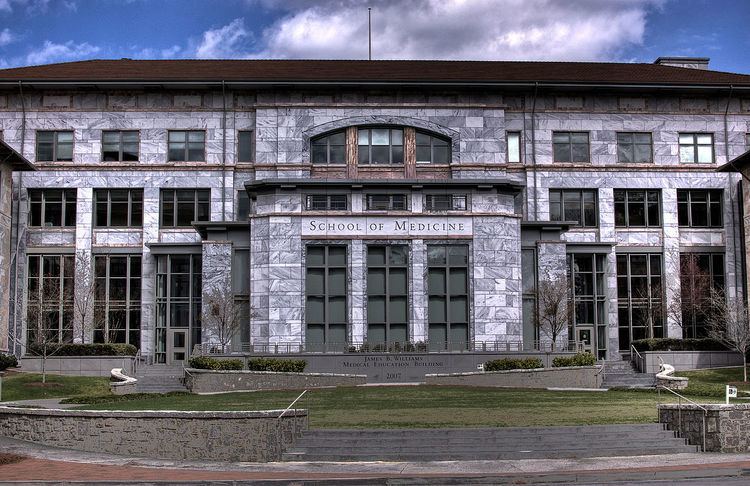Phone +1 404-727-5640 Founded 1915 | Students 455 Undergraduate tuition and fees 43,300 USD (2010) Total enrollment 522 (2010) Dean Thomas J. Lawley | |
 | ||
Address 1648 Pierce Dr NE, Atlanta, GA 30307, USA Notable alumni Hamilton E Holmes, Larry McDonald, Erica Dixon, Betty Price, Bruce Bode Similar Emory University, Oxford College of Emory Un, Morehouse School of Medicine, University of California, Baylor College of Medicine | ||
The Emory University School of Medicine is the Graduate Medical School of Emory University and a component of Emory’s Robert W. Woodruff Health Sciences Center. It is consistently ranked among the top institutions for biomedical education, clinical care, and research in the United States. Emory University School of Medicine traces its origins back to 1915 when the Atlanta Medical College (founded 1854), the Southern Medical College (1878), and the Atlanta School of Medicine (founded 1905) merged.
Contents
Admission and societies
In 2011, the entering class of 138 medical students hailed from 63 different colleges and had an average undergraduate GPA of 3.7 and an average MCAT of 34. In the 2011 entering class, 63% of students majored in science or engineering, 25% majored in humanities, and 12% majored in both science and humanities. Upon matriculation, medical students are divided into four societies through which they participate in small group learning exercises that foster differential diagnosis abilities, clinical skills, and professional development. The societies are named after four historic physicians who contributed significantly to the practice of medical science during their lifetimes.
William Harvey (1578 – 1657) English physician, best remembered for correctly describing the circulation of blood through the heart. In 1628, he published Exercitatio Anatomica de Motu Cordis et Sanguinis in Animalibus (An Anatomical Exercise on the Motion of the Heart and Blood in Living Beings), a review of his careful observations, measurements, and remarkable experiments.
He subsequently was named physician to King Charles I.
Ignaz Semmelweis (1818 – 1865) Viennese obstetrician/gynecologist. Iconoclast and advocate for women’s health, he correctly described the infectious cause of Puerperal Fever (now known to be Streptococcal post-partum infection). Despite considerable scorn from his peers, he proved that hand washing saves lives; he is remembered as “The Saviour of Mothers.”
Joseph Lister (1827 – 1912) British surgeon. Deploring the high incidence of post-surgical wound infection and death from post-operative sepsis, Lister deduced that these diseases were preventable. A meticulous surgeon and scientist, he applied Semmelweis’ and Pasteur’s observations to clinical practice, and used carbolic acid solutions to clean wounds, clean surgical instruments, and to clean surgeon’s hands. A shy and unassuming man, his initial work was met with indifference; his persistence and eventual vindication resulted in the development of surgery into a life-saving and safe medical practice.
Sir William Osler (1849 – 1919) Canadian physician. Brilliant clinician-scientist, Osler transformed the organization and curriculum of medical education, emphasizing the importance of clinical experience and applied science. Osler's textbook Textbook of Medicine was well written, comprehensive, scholarly, and set the standard for subsequent medical texts. Osler was famous for many aphorisms which are still as cogent today as when he first introduced them: “To study medicine without reading textbooks is like going to sea without charts, but to study medicine without dealing with patients is not going to sea at all.”
Curriculum
The curriculum features a condensed pre-clinical learning phase in which students cover the basic medical sciences in 1.5 years. Students typically take the USMLE Step 1 by February of their second year allowing them to begin their medical clerkship phase at Emory-affiliated hospitals. The unique design of the curriculum allows for a 5-month Discovery Phase in the third year which encourages students to pursue research in any medically related field including basic science, translational medicine, clinical research, public health, among others. The Emory University School of Medicine offers a variety of dual degree programs including MD-Masters in Public Health, MD-Masters in Clinical Research, MD-Masters in Business Administration, MD-MA in Bioethics, and MD-PhD (the PhD can be completed through the Emory University Laney Graduate School, Rollins School of Public Health, or the Georgia Institute of Technology).
Training facilities and affiliated institutions
The School of Medicine is located on the main Emory University campus in the Druid Hills section of Atlanta and in Emory-owned and affiliated medical facilities throughout metropolitan Atlanta including Grady Memorial Hospital, Emory University Hospital, Emory University Hospital Midtown, Atlanta Veterans Affairs Medical Center and Children's Healthcare of Atlanta. Many of these hospitals are part of Emory Healthcare. Affiliated research institutions include Yerkes National Primate Research Center and the Centers for Disease Control and Prevention.
Rankings
In its 2013 rankings of the best medical schools in the United States, U.S. News and World Report placed Emory University School of Medicine at #22 in research and #29 in primary care.
